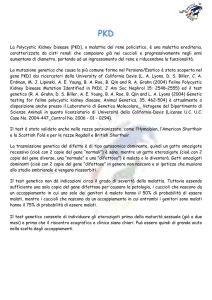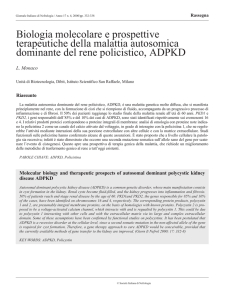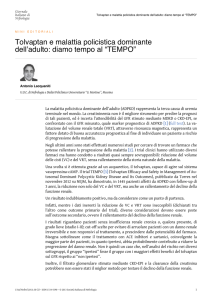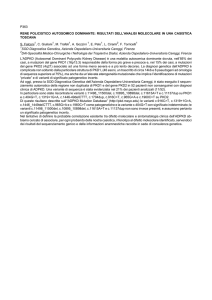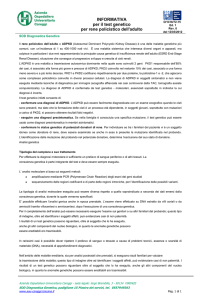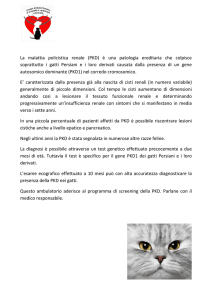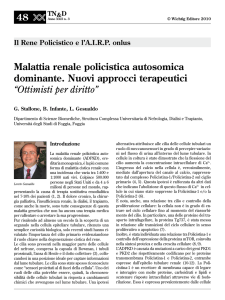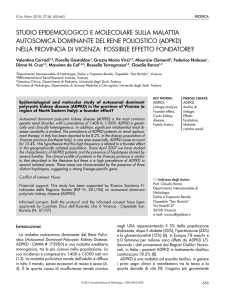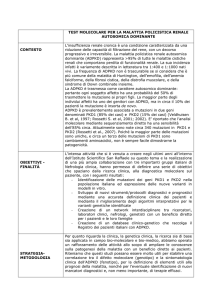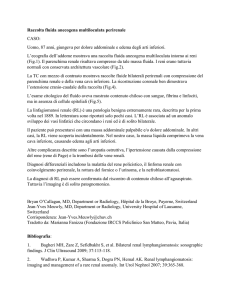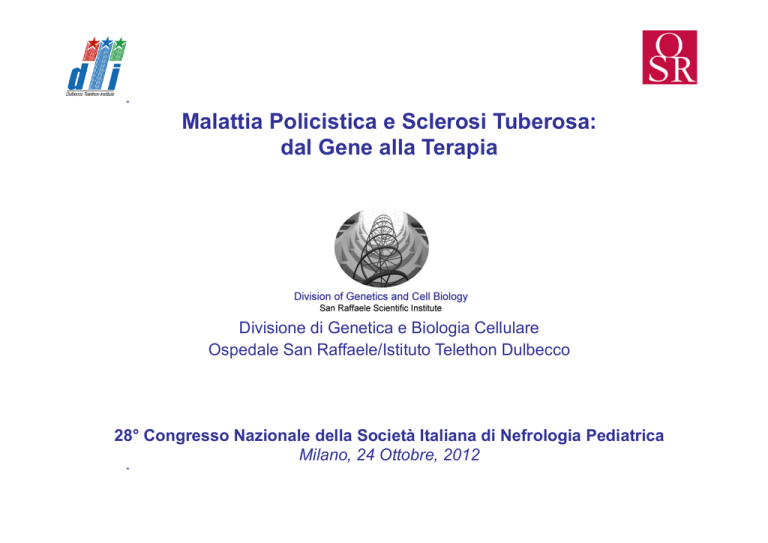
Malattia Policistica e Sclerosi Tuberosa:
dal Gene alla Terapia
Divisione di Genetica e Biologia Cellulare
Ospedale San Raffaele/Istituto Telethon Dulbecco
28° Congresso Nazionale della Società Italiana di Nefrologia Pediatrica
Milano, 24 Ottobre, 2012
1) Polycystic Kidney Diseases:
- Autosomal Dominant (ADPKD) also called the “adult form”
- Autosomal Recessive (ARPKD) also called “of the Child”
Recently, patients carrying hypomorphic mutations of the ADPKD gene in
homozygosity were also identified!! No time to talk about this today
2) Tuberous Sclerosis Complex (TSC):
- 80% of patents develop renal angiomyolipoma, 20% develop cysts
- PKD1/TSC2 Contiguous genes Syndrome: severe PKD
Autosomal Dominant Polycystic Kidney
Disease (ADPKD)
1/500-1/1000 of the general population
Characterized by bilateral renal cysts formation.
Systemic Disease:
liver and pancreatic cysts.
Cardiovascular defects, Intracranial and aortic
aneurysms.
Important cause of End Stage Renal Disease (ESRD),
which occurs by age 50 in 50% of the patients (but a
significant fraction is already present in infants)
Autosomal Dominant Polycystic Kidney
Disease (ADPKD)
Mutations of 2 genes:
PKD1
85% of all cases, chromosome 16p13.3
PKD2
15% of cases, chromosome 4q22
ADPKD è dovuta a mutazioni loss-of-function disperse
lungo i due geni
Truncating Mutations
In-frame mutations
Rossetti et al, J Am Soc Nephrol, 2007
End Stage Polycystic Kidney (ADPKD)
PKD Foundation, www.pkdcure.com
Autosomal Recessive Polycystic Kidney
Disease (ARPKD)
1/10,000-1/40,000 of the general population
Characterized by bilateral renal cysts formation.
Liver cysts (hepatomegaly) are always
present, but might not be yet visible at birth
Severe Hypertension
Oligohydramnios causing pulmonary
hypoplasia is a frequent cause of death at birth
(secondary)
Neonatal/infant presentation in the majority of
cases, but it can present in late childhood and
adults
Autosomal Dominant Polycystic Kidney
Disease (ADPKD)
Mutations of a Single gene:
PKHD1
chromosome 6p21
A very large gene which, undergoing a number of alternative
splicing and having mutations dispersed all along the gene
Autosomal Recessive Polycystic Kidney Disease (ARPKD)
Figure 1. Renal pathology of autosomal recessive polycystic kidney disease. A, Kidney of a 2-year-old ARPKD-affected
child.
L.F. Menezes and L.F. Onuchic.. Braz J Med Biol Res 2006; 39: 1537-1548.
Polycystins Structure
CRS
Signal peptide
LRRs
CRS
C-type
lectin
LDL-A
PKD
repeats
Ca++
Ca++
Ca++ ++
Ca
Ca++
REJ
Extracellular
GPS
PLAT
PC-1
β
α
γ
EF-H
ER
Intracellular
PC-2
Polyductin/Fibrocystin
The “Cystoproteins”-Cilia Connection:
Sensing Flow to Maintain the Tubular Diameter?
Watnick and Germino, Nat Genet N&V, 2003
The Planar Cell Polarity (PCP) Hypothesis, I
oriented cell division
Germino GG
Nat Genet N&V, 2005
The Planar Cell Polarity (PCP) Hypothesis, II
convergent extension movements
Planar polarity in the developing kidney: convergent extension
Important to note that the role of primary cilia in embryonic cyst formation has been
challenged and it is possible that this process might NOT be cilia-dependent
Polycystic Kidney Diseases
Two-hit model of cystogenesis in ADPKD
Nefrone Normale
Nefrone policistico
Second Hit
(somatic mutation)
*
Glomerulus
Tubule
Qian F et al, Cell 87: 979-87, 1996
*
* * **
*
*
*
*
*
* * **
Cascate aumentate o diminuite nel rene policistico e potenzialmente
utilizzate come targets terapeutici (primari or secondari?)
Torres V and Harris P Annu Rev Med 2009
Trials with Vasopressin receptor antagonists
ADPKD cyst growth progresses more slowly with tolvaptan than in
historical controls
very strong side effects (thirst and abnormally frequent urination)
The Tuberous Sclerosis Complex (TSC)
-Autosomal Dominant Genetic disease with an incidence of 1/6000
-2 genes causing the tuberous sclerosis clinical phenotype, TSC1 (approx
15%) and TSC2 (Approx 75%).
-Hamartomas, often due to Loss of heterozygosity (LOH) for TSC1 and/or
TSC2.
- Neurological disorder: mental retardation and seizures
Main Manifestations:
Facial Angiofibromas
Hypomelanotic macules
Cortical Tubers
Subependymal nodules
Giant Cell Astrocytomas
Cardiac Rhabdomas
Renal:
Almost all Patients have a renal manifestation:
80% benign Angyomyolipomas
Sporadic Renal Cysts Formation
Malignant Angiomyolipomas
Renal Cell Carcinoma
-About 20% of patients have multiple and bilateral renal cysts formation
The PKD/TSC Contiguous Syndrome
-A PKD/TSC contiguous syndrome caused by large deletions of
Chromosome 16 has been reported
-Patients manifest a VERY SEVERE Polycystic Kidney Disease
The Tuberous Sclerosis Complex (TSC) proteins regulate mTORC1
Frizzled "
TKR "
(InsR)"
wnt "
Akt" PDK" PI3k"
AMP/ATP"
mTORC2! Ras"
GSK3β"
LKB1"
HIF-1α"
AMPK"
TSC1"
MEK"
TSC2"
ERKs"
Rheb"
p90RSK"
REDD1"
Hypoxia"
mTORC1!
Raf"
Torres, Boletta et al, CJASN, 2010"
Dvl "
aminoacids"
TSC and PKD co-operate somehow in regulating mTORC1?
?
Golgi Apparatus
A
TSC2
B
TSC2
?
?
Endoplasmic reticulum
TSC2
TSC1 TSC2
mTORC2
?
mTORC1
Nucleus
mTORC1
A. Boletta, Pathogenetics, 2009
Evidence from pre-clinical animal models seemed to
suggest that rapamycin might be a good treatment for PKD
Torres, Boletta et al, CJASN, 2010
…But unfortunately, the results from the first clinical trials
were a cold shower…
• No improve of the kidney function
• High drop-out rate: heavy side effects
Aknowledgements
Current Lab members:
Maddalena Castelli
Marco Chiaravalli
Chiara De Pascalis
Gianfranco Distefano
Monika Pema
Isaline Rowe
Past Lab members:
Valeria Ulisse
Claas Wodarczyk
Giovanna Musco Lab
Valeria Mannella
Silivia Mari
Giacomo Quilici
York Pei Lab, University of Toronto
Xueweng Song
Feng Qian Lab, University of Maryland
Huangxue Xu
Giorgio Casari Lab
Laura Cassina
Alembic
Miriam Ascagni
Maria Carla Panzeri
Dr. S. Bramani, Private Donation

